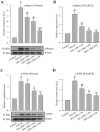Induced pluripotent stem cell-conditioned medium suppresses pulmonary fibroblast-to-myofibroblast differentiation via the inhibition of TGF-β1/Smad pathway
- PMID: 29115383
- PMCID: PMC5746308
- DOI: 10.3892/ijmm.2017.3199
Induced pluripotent stem cell-conditioned medium suppresses pulmonary fibroblast-to-myofibroblast differentiation via the inhibition of TGF-β1/Smad pathway
Abstract
Therapeutic strategies based on stem cells have been shown to have potential in improving the condition of severe lung diseases. In this study, the suppressive effects of conditioned medium (CM) of induced pluripotent stem cells (iPSCs) on pulmonary fibroblast differentiation were investigated in a series of in vitro and in vivo experiments. Moreover, the underlying mechanisms through which iPSC-CM inhibited the differentiation of fibroblasts into myofibroblasts were explored as well. iPSCs were generated using a mouse 3-gene transfection method, myofibroblast-like cells were induced by incubating human fibroblasts with transforming growth factor-β1 (TGF-β1) and mouse models of pulmonary fibrosis (PF) were established by an injection of bleomycin. Based on these experiments, the effects of iPSC-CM on collagen accumulation, lung structure and the TGF-β1-mediated pathway were determined. It was found that treatment with iPSC-CM markedly reduced the proliferation of TGF-β1-exposed cells, and the activities of TGF-β1, Smad-2 and Smad-3. Accompanied by alterations in the expression of the indicated molecules, the lung structure of mice with PF was also markedly ameliorated. The present study confirmed the protective effects of iPSC-CM on lung tissue against PF, and it was also inferred that the ameliorating function of iPSC-CM on PF may be exerted through the blocking of TGF-β1/Smad signal transduction pathway.
Figures










References
-
- Perez A, Rogers RM, Dauber JH. The prognosis of idiopathic pulmonary fibrosis. Am J Respir Cell Mol Biol. 2003;29(Suppl 3):S19–S26. - PubMed
MeSH terms
Substances
LinkOut - more resources
Full Text Sources
Other Literature Sources
Medical

